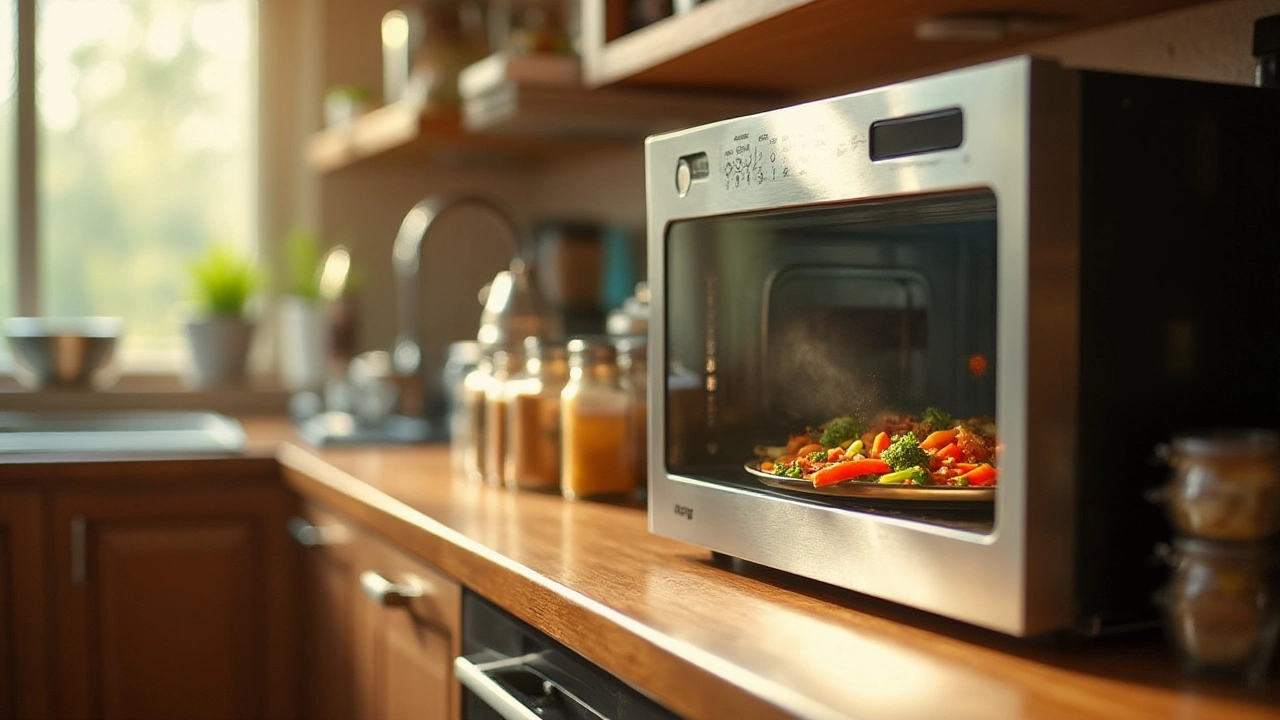
Microwave ovens have become an indispensable part of modern kitchens, but their potential goes far beyond just reheating cold meals. It's easy to overlook just how versatile these appliances can be. In this article, we'll delve into three unexpected yet incredibly practical uses of microwave ovens that could transform the way you use your kitchen space. Whether you're looking to save time or simplify tasks, these tips are bound to become part of your daily routine.
Steam Vegetables in a Jiffy
The microwave oven, a staple in kitchens around the world, has some tricks up its sleeve that many of us haven't yet discovered. One such clever trick is the ability to steam vegetables at warp speed. Say goodbye to the cumbersome pots and lengthy wait times for your veggies to soften on the stove. Steaming vegetables in the microwave not only saves time but also helps to retain more nutrients, as they cook quickly in their own moisture. The shorter cooking time results in better preservation of vitamins and minerals compared to traditional boiling, where much of the goodness is lost in the water.
Let’s talk about the science behind it. Microwaving vegetables works by heating the water molecules within the food rather than heating from the outside in. This ensures more even and quicker cooking, making it ideal if you're in a rush. For instance, studies show that broccoli cooked properly in a microwave retains up to 90% of its vitamin C content, far more than its boiled counterpart. Convenience meets health benefits—who knew we could have the best of both worlds?
Ready to try it? Here’s how you can easily steam vegetables in your microwave. Start by cutting your chosen vegetables into uniform pieces to ensure even cooking. Place them in a microwave-safe bowl and add just a tablespoon or two of water; too much water is unnecessary and can result in sogginess. Cover the bowl with microwave-safe plastic wrap, leaving a small corner open to vent. This creates a steam dome, allowing moisture and heat to circulate as the food cooks. Set your microwave on high, and cook the veggies for about 2-3 minutes, or until they are bright in color and tender-crisp.
According to Kitchen Science author Harold McGee, "Microwave steaming can be a more efficient way to cook, reducing not just time, but also energy expenditure in the home kitchen."
Feeling adventurous? Consider seasoning your veggies before microwaving. A sprinkle of salt, a dash of pepper, or a squeeze of lemon can infuse flavors without added cooking steps. For a bit of zest, add garlic powder or some dried herbs right before cooking. These small tweaks elevate the taste profile, ensuring your steamed veggies are a healthy and delicious part of any meal. And the best part? All this is achieved without creating a mess in the kitchen.
The next time you find yourself in need of quickly prepared, nutrient-packed vegetables, look no further than your trusty microwave oven. It's a small change in routine, but with massive benefits. You’ll be amazed at how such a simple, quick technique can revolutionize your kitchen habits, turning steaming vegetables into not only an easy task but also a delightful part of your cooking journey.

Poach Perfect Eggs
For many home cooks, poaching eggs can be a bit of a kitchen conundrum. Achieving a tender egg with a runny yolk, reminiscent of brunch outings, often seems a mystery shrouded in simmering water and swirling techniques. Yet, there's a game-changing strategy that involves none other than your trusty microwave oven. This straightforward method eliminates the need for stovetops and precision pour techniques, making it accessible to novices and culinary experts alike. By harnessing the power of microwave ovens, you can produce perfectly poached eggs at home, swiftly and with minimal fuss.
The process begins with a large, microwave-safe bowl filled with about half a cup of water. It's essential the bowl is large since the egg needs space to move gently in the water while cooking. Crack an egg into the water as carefully as you can, ensuring that the yolk remains intact. The next step utilizes the microwave's unique ability to rapidly produce heat energy. You'll want to cover the bowl with a microwave-safe plate to trap steam inside, aiding in cooking the egg evenly. Cook on high heat for about 45 seconds to one minute. Remember to stand nearby as microwaves can vary in strength and the results may differ slightly based on altitude and egg size.
According to culinary expert Julia Child, "The only real stumbling block is fear of failure. In cooking, you've got to have a what-the-hell attitude." With microwave egg poaching, you can embrace this wisdom with confidence.
A key aspect to monitor is the white's texture; it should be firm but not rubbery. On the other hand, the yolk should still have a gentle wobble. It's always a good practice to allow the egg to sit in the hot water for about thirty seconds after the microwave beeps, as this can ensure even cooking without over-hardening the yolk. Carefully remove the egg using a slotted spoon, letting excess water drip off, and voilà, you have a restaurant-quality poached egg. It's ideal for topping toasts, salads, or even enhancing a simple bowl of grains or noodles. This method not only saves time but also reduces clean-up, one of the many reasons why it’s a beloved kitchen hack.
It's worth noting that using a microwave oven for this task retains the flavor and integrity of the egg, as it's one of the gentlest cooking methods available. The gentle steam creates a uniform result with minimal chances of breakage, making it a fantastic tool even for those busy mornings. You might even experiment by adding other elements like a splash of vinegar to the water to aid with coagulation, or try infusing herbs for added flavor. Whatever route you choose, the microwave proves to be a secret weapon for egg aficionados.

Sterilize Kitchen Items
In the quest for a cleaner and more hygienic kitchen, your trusty microwave oven might just become your best ally. While it's well-known for its ability to zap food, it also excels in sterilizing small kitchen items. This might come as a surprise, but the intense heat generated within a microwave can efficiently kill bacteria and germs on items like sponges and cutting boards, ensuring a cleaner cooking environment with minimal effort.
To sterilize kitchen items, you need to begin by understanding which materials are safe to microwave. Generally, non-metallic items such as sponges, dishcloths, and plastic cutting boards designed for microwave use can undergo this process. It's crucial to ensure that these items are microwave-safe, as some plastics can melt or leach harmful chemicals when exposed to heat. So, always double-check any manufacturer's instructions before proceeding.
Now, let's delve into the step-by-step method to effectively use your microwave for sterilization. First, dampen your sponge or cloth either with plain water or a mixture of water and white vinegar. Vinegar acts as a natural disinfectant and adds an extra layer of cleaning power. Place the damp item on a microwave-safe plate and heat it on high for about 90 seconds. This short burst of heat is usually enough to rid the sponge of 99.9% of the bacteria. For cutting boards, one can spray them with lemon juice or vinegar, then microwave on high for 2-3 minutes. This not only sanitizes the board but also helps in deodorizing it, leaving your kitchen with a fresh scent.
According to research by the USDA, microwaving kitchen sponges at least once every two days significantly decreases bacterial contamination, contributing to overall kitchen hygiene.
When tackling a more persistent odor, a slice of lemon can be placed on the sponge before microwaving. This can enhance both the cleaning and deodorizing effects. Always use caution and allow items to cool slightly before handling, as the contents will be extremely hot immediately after microwaving. Do note that certain items like metal-based utensils or those with decorative metal trims should not be placed in a microwave due to the risk of sparks.
For a visual representation of safety precautions, take a look at this data from a kitchen health survey conducted in 2022.
| Precaution | Percentage of People Following |
|---|---|
| Check Microwave Compatibility | 85% |
| Use Tongs or Oven Mitts | 68% |
By integrating the regular sterilization of kitchen items into your cleaning routine, you are not just maintaining cleanliness; you are transforming your kitchen into a safer space for all culinary activities. Hidden in plain sight, the microwave offers an efficient and environmentally friendly option for keeping harmful germs at bay, leaving you with peace of mind and a conveniently germ-free home.